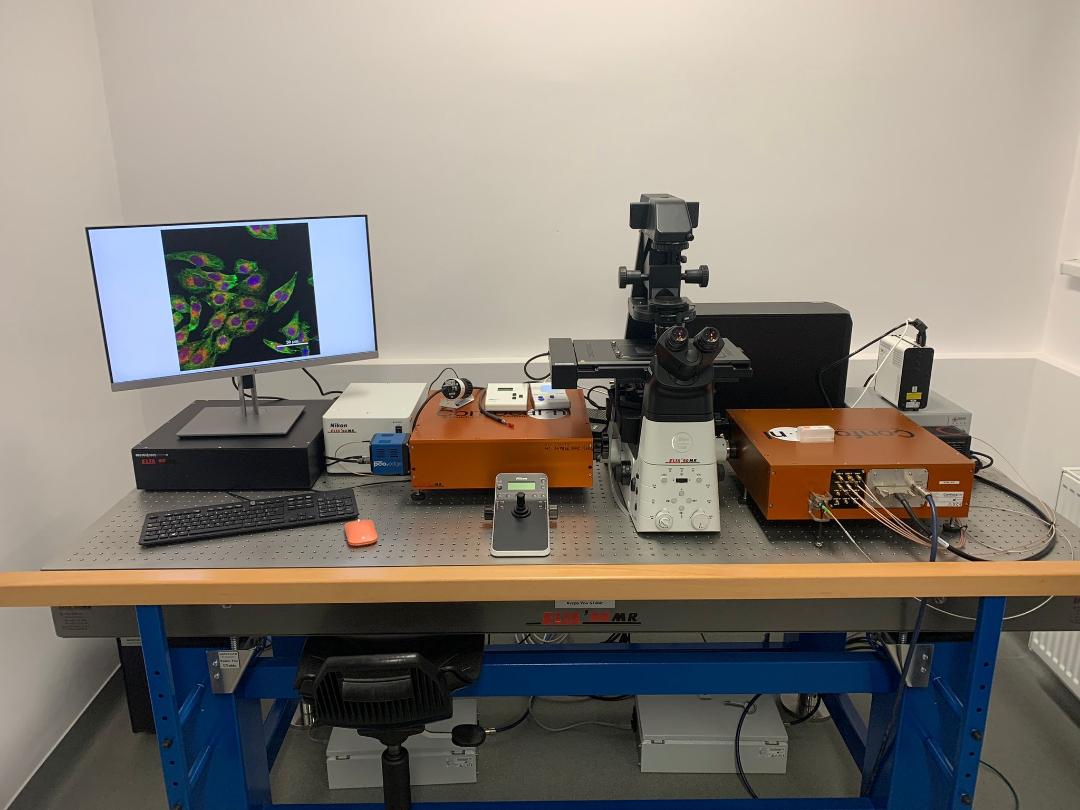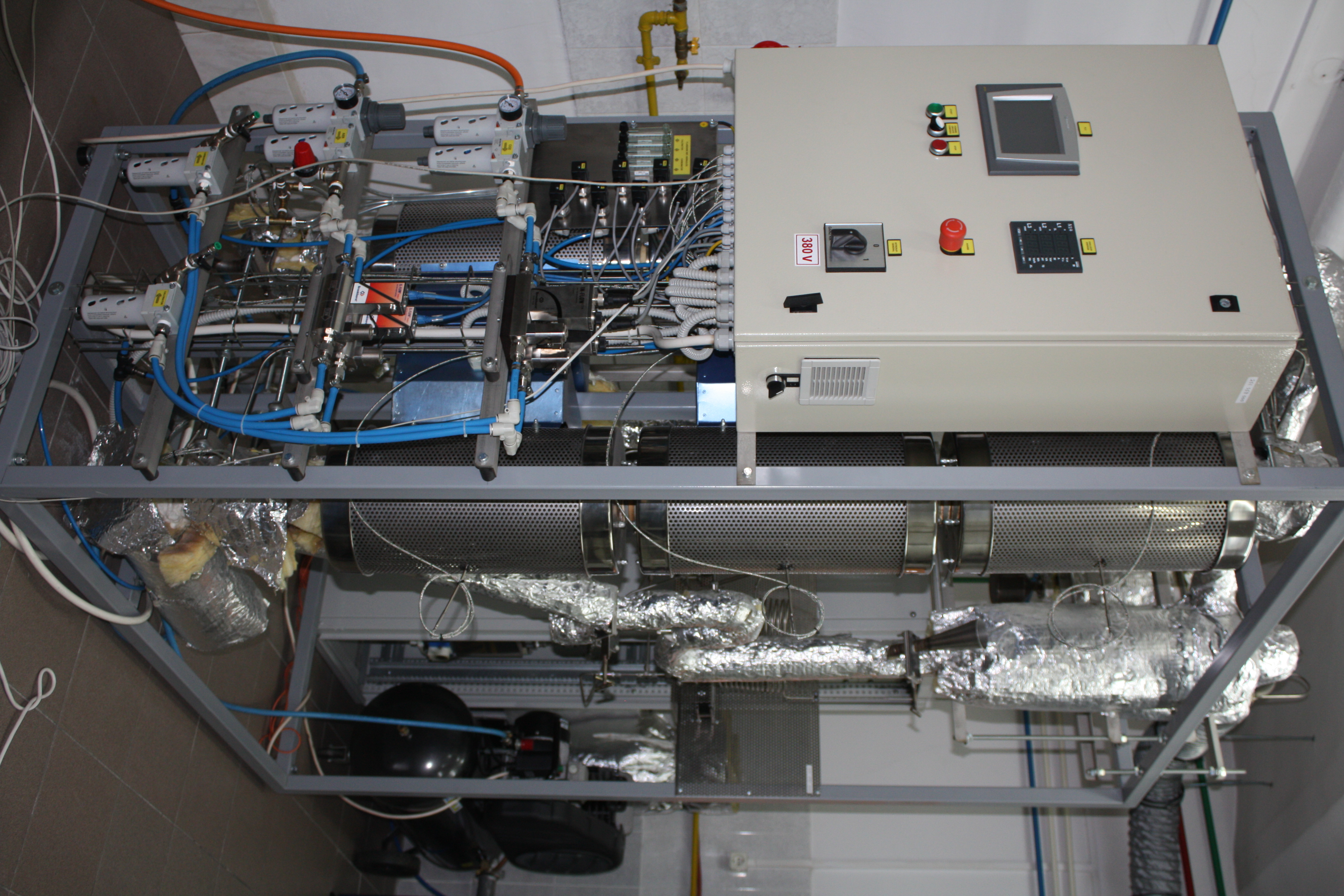You are here :
- EUTOPIA website
- Home
- Research & Innovation
- Research Infrastructure
- Infrastructure Brochure
Research Infrastructure - Babes-Bolayi University, Cluj-Napoca - Romania
-
High Field Magnetic Resonance Spectroscopy and Imaging Infrastructure (NMR & EPR Platform)

Nuclear Magnetic Resonance (NMR) is one of the most powerful tools for addressing numerous biological, chemical and physical open questions across scientific disciplines. A central element of the platform is represented by a 3 Tesla Siemens Skyra MRI which allows all the imagistic applications available for a standard 3T scanner (angiography, cardiology, abdominal, perfusion and diffusion tensor imaging, nervous tract visualisation, functional imaging, diffusion, spectroscopy and dynamic breast imaging). To increase the methods capabilities to get information at atomic and molecular level coming from living forms, materials or molecules the infrastructure comprises also other MRI, NMR and electron spin resonance/electron paramagnetic resonance (EPR/ESR) equipment.
Keywords:
• Advanced Imaging – MRI in Clinical Cognitive Sciences • Solution NMR • Solid state-NMR • EPR/ESR • Life science • Small molecules • Proteins • Materials science
Key Contact:
Prof. Ph.D. Anca Dobrean (for MRI)
Ph.D. Ioan Dan Poromb (for NMR)
Prof. Ph.D. Radu Silaghi-Dumitrescu (for EPR)
ubbcluj.ro
-
"Star-Gate Psy" Matrix Platform Robotics and Visual Reality

The platform is part of the «Star-Gate Psy» project for the identification of innovative technologies for optimizing and developing the mind and human potential, supporting the program of Robotics and Psychotherapy through Virtual Reality from the Department of Clinical Psychology and Psychotherapy at Babes-Bolyai University. The «PsyTech-MATRIX» platform currently has a Center for Psychotherapy through Robotics/Robotherapy and Virtual Reality, which also has several Laboratories (Stress Control, Pain Control, Virtual Classroom, Star Trek-Holodeck; Robot-based and Online/Computer-based Therapy) equipped with the most advanced technology and «know-how» currently available at
the international level.
Keywords:
• Psychotherapy • Robotherapy • Virtual Reality • Stress Control • Pain Control
Key Contact:
Prof. Ph.D. Anca Dobrean
Dr. Silviu Matu
ubbcluj.ro
-
X-Ray Diffractometry Platform

X-ray diffraction (XRD) is a nondestructive technique used to analyse the structure of crystalline materials from molecular level and for characterization of crystalline, partially crystalline or non-crystalline materials. The XRD equipment allow the structural characterization of organic and organometallic compounds and the determination of crystalline phase on minerals, rocks, and industrial materials (ceramics, concretes) with applications in Mineralogy, petrology, advanced materials and environmental science.
Key Words:
• Single-crystal XRD • Powder WRD
Key Contact:
For D8 Venture Single Crystal X-Ray Diffractometer:
Assoc. Prof. Ph.D. Richard Varga
For Shimadzu XRD-6000:
Ph.D. Marieta Muresan-Pop
ubbcluj.ro
-
The Electron Microscopy Platform

The Electron Microscopy Platform is a research base with multiple users, designed for high scientific research and education/specialisation of young researchers in the morphological and surface area analysis using TSM and SEM instruments. Its activities cover a large number of scientific domains: physics, chemistry, geology, mineralogy, geography, animal and plant biology (with special emphasis on cellular and molecular biology, biochemistry and physiology) pharmacology, human and animal medicine, ecology and environment protection, as well as industry areas, such as: food technology, mining, oil industry, metallurgy and chemical industry.
The platform includes also an Electron Probe Micro Analyzer which can perform micron scale quantitative analysis and deliver high quality minor and trace element analyses due to the low down to 100 ppm detection limit. Also, it can perform chemical mapping at high spatial resolution.
Key Words:
• TEM • SEM • HRTEM • Life sciences • Biology • Medicine • Polymers • Minerals and advanced materials • Chemical dating geochronology • Element mapping in solid substances
Key Contact:
For Tem Hitachi H-7650:
Assoc. prof. Ph.D. Gabriel Katona
For CAMECA SX-FIVE Electron Microprobe:
Ph.D. Sergiu Dragusanu
For TEM JEOL 1010 AND SEM + EDX JEOL JSM 5510LV :
Assoc. Prof. Ph.D. Lucian Barbu-Tudoran
ubbcluj.ro
-
Mass Spectrometry Platform

The Mass spectrometry platform available in Babes-Bolyai University offer the possibility of analysis and characterization for organic, organometallic compounds, supramolecular associations, peptides, proteins, polymers, inclusive complex mixture from biological samples. The HRMS infrastructure affords the recording of high-resolution mass spectra and the determination of exact mass
of the analysed compounds with accuracy below 3 ppm. The mass spectrometers have specific software and databases as well as the necessary auxiliar instrumentations for Sample Separation to provide the best resolution, sensitivity, and selectivity. The platform includes also ICPMS spectrometer that has been purpose-designed to deliver rapid and precise isotope ratio and quantitative analysis of trace elements in solid and liquid matrices.
Key Words:
• HRMS • MS • MALDI • HR-ICP-MS • GC-MS • LC-MS
Key Contact:
For LC/MS AGILENT TRIPLE QUAD 1200/6410 :
Prof. Ph.D. Monica Tosa
For HRMS LTQ ORBITRAP XL :
Assoc. Prof. Ph.D. Niculina Hadade
For GC-MS SHIMADZU QP101 PLUS :
Assoc. Prof. Emese Gal
For LA-HR-ICP-MS-NU-ATTOM :
Ph.D Dan Nita
https://research.ubbcluj.ro/infrastructure/category/platforms/mass-spectrometry-platform/
-
Fluorescence Microscopy Platform

The Time-resolved confocal fluorescence microscope is adapted for different types of measurements/modes of data analysis: FLIM, FCS, FRET, measurement of fluorescence lifetimes in liquid or solid samples, unimolecular spectroscopy, nonlinear optics measurements, monitoring of fluorescence signal fluctuations. Possible applications: FLIM on biological structures (cells, tissue) or materials with luminescent properties; characterization of the interaction of some exo- or endogenous chromophores with (plasmonic) nanoparticles applied in therapy, diagnosis and imaging; Cell biology; Non-linear optics; Two-photon imaging. The confocal microscopy system (Re-scan Confocal Microscopy - RCM) is based on the "double scan" method (a scan of the laser beam simultaneously with a scan of the beam emitted by the sample). This innovative method leads to obtaining a much better lateral resolution than in standard confocal microscopy. This peculiarity of scanning and respectively high resolution gives to our microscopy system a high degree of uniqueness both nationally and internationally; 2 re-scanning RCM units: for the NIR domain, with lateral resolution of 240 nm (RCM-NIR) and 140 nm respectively for the visible domain (RCM-VIS); the RCM-NIR unit is equipped with two laser diodes with emission lines at 640 and 785 nm, respectively.
Keywords:
• FLIM • FRET • FCS • Two-photon excitation • Nonlinear optics • Unimolecular detection sensitivity • High-resolution confocal fluorescence (bio)imaging • 3D fluorescence imaging • NIR confocal imaging • Immunofluorescence • Intracellular uptake studies
Key Contact:
Ph.D. Monica Focsan
ubbcluj.ro
-
Experimental Infrastructure for Energy Conversion Systems with CO2 Capture
Various modules of the energy conversion system with CO2 capture capability research infrastructure allow the experimental evaluation of gas-liquid absorption, chemical and calcium looping technologies (reactive gas-solid systems) in various operational modes such as fixed bed, fluidized bed or circulating fluidized bed (CFB). The range of operational parameters (e.g., temperature up to 1200 degree Celsius, various composition of gas streams to be decarbonized, various
liquid and gaseous fuels etc.), online monitoring and control of the experimental modules using computer as well the analytical equipments (online Siemens gas-analyzer and gas chromatograph) make this advanced research infrastructure very valuable to assess various gas-solid and gas-liquid CO2 capture technologies. In addition, the modelling and simulation capabilities of the research team (using a wide range of softwares such as ChemCAD, Aspen, Matlab/Simulink, Comsol, Thermoflex, GaBi etc.) are used in conjunction with this
relevant experimental infrastructure to perform techno-economic and environmental evaluations of energy conversion systems with CO2 capture feature.
Keywords:
• CO2 capture technologies • Chemical and calcium looping • Gas-liquid absorption • Gas-solid systems • Energy conversion systems • Techno-economic and environmental evaluations • Life Cycle Assessment (LCA)
Key Contact:
Prof. dr. Calin Cormos
ubbcluj.ro
-
Center for High-Performance Computing
The Center for High Performance Computing serves as an infrastructure for computational research at the Babeș-Bolyai University of Cluj-Napoca. Our HPC infrastructure supports research groups in a variety of scientific domains such as mathematics, computer science, physics, chemistry, biology, geography, meteorology, communication science and business/economics.
Keywords:
• High Performance Computing: IBM NextScale • Cloud computing: IBM Flex System
Key Contact:
Prof. Ph.D. Gheorghe Cosmin Silaghi
ubbcluj.ro
-
The Herbarium of Babes-Bolayi University
The herbarium is a vast catalogue of plants where each of the specimens included provide unique information – where it was found, the morphological variability of the plant, preferred habitat, phenology (when it blooms or produces seeds), etc. Last but not least, due to the new techniques of DNA molecule analysis, herbaria are genuine gene banks that document the biodiversity of the
plant world at the molecular level. The DNA, which remains intact for many years, is now extracted from herbarium specimens, thus providing information on plant relations and evolutionary processes.
Keywords:
• DNA molecule analysis • Genuine gene banks • Biodiversity; • Plant specimens
Key Contact:
Assoc. Prof. Dr. Mihai Puscas
ubbcluj.ro
-
The Romanian 3D Atmospheric Research Observatory, Cluj Station

The Romanian 3D Atmospheric Research Observatory – Cluj Station is to research the composition of the atmosphere (gases, aerosols and clouds). Atmospheric processes such as gas and aerosol dynamics, radiative effects, effects on climate, cloud formation are also studied. The laboratory has been in operation since 2009 and is currently integrated into several international aerosol atmospheric research networks: EARLINET – European Aerosol Research Lidar Network; NASA – AERONET – Aerosol Robotic Network.
Keywords:
• Atmosphere composition • Atmospheric processes • Aerosol dynamics • Radiative effects • Cloud dormation
Key Contact:
Ph.D. Eng. Nicolae Ajtai
ubbcluj.ro





